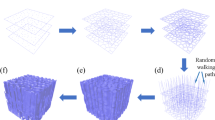Abstract
In the coculture system of periostless metatarsal bones of 17-day-old fetal mice and osteoclast progenitors, osteoclasts will develop. Our goal in the present report was to provide further evidence that in the coculture system of fetal metatarsal bone rudiments with hemopoietic cells, the osteoclasts developing inside the bone rudiments are exclusively derived from the cells suspended in the plasma clot and not from endogenous precursor cells of the bone explants themselves, by using the technique of in situ hybridization with a probe for the mouse Y chromosome. Osteoclast formation in unstripped male metatarsal rudiments, occurring after 3–4 days of culture, was compared with osteoclast formation in cocultures of female metatarsal rudiments and male bone marrow cells, occurring after 5–6 days of culture. Osteoclasts were recognized by their tartrate-resistant acid phosphatase activity. In paraffin sections of cultured male metatarsals, the mean percentage of microscopically identifiable osteoclast nuclei, in which the Y chromosome could be detected, was 43.1±4.2% (n=12). For cocultures of female metatarsal bones and male bone marrow cells this mean percentage was 40.9±5.7% (n=17). Statistical comparison by means of the two sample t-test indicated no significant difference in the percentages of osteoclast nuclei containing the Y chromosome for both groups. We concluded that the osteoclasts do derive from cocultured cells and not from precursor cells in the bone explant itself. Therefore, the coculture system is a reliable in vitro system for studying osteoclast formation from progenitor/precursor cells.
Similar content being viewed by others
References
Thesingh CW, Burger EH (1983) The role of mesenchyme in embryonic long bones as early deposition site for osteoclast progenitor cells. Dev Biol 95:429–438
Burger EH, van der Meer JWM, van de Gevel JS, Gribnau JC, Thesingh CW, van Furth R (1982) In vitro formation of osteoclasts from long-term cultures of bone marrow mononuclear phagocytes. J Exp Med 156:1604–1614
Burger EH, van der Meer JWM, Nijweide PJ (1984) Osteoclast formation from mononuclear phagocytes: role of bone-forming cells. J Cell Biol 99:1901–1906
Löwik CWGM, van der Pluijm G, van der Wee-Pals LJA, Bloys van Treslong-de Groot H, Bijvoet OLM (1988) Migration and phenotypic transformation of osteoclast precursors into mature osteoclasts: the effect of a bisphosphonate. J Bone Miner Res 3:185–192
Schneider GB, Relfson M (1989) Pluripotent hemopoietic stem cells give rise to osteoclasts in vitro: effects of rGM-CSF. Bone Miner 5:129–138
Lenhard S, Popoff SN, Marks SC Jr (1990) Defective osteoclast differentiation and function in the osteopetrotic (os) rabbit. Am J Anat 188:438–444
van der Pluijm G, Löwik C, de Groot H, Alblas MJ, van der Wee-Pals LJA, Bijvoet OLM, Papapoulos SE (1991) Modulation of PTH-stimulated osteoclastic resorption by bisphosphonates in fetal mouse bone explants. J Bone Miner Res 6:1203–1210
Antonioli Corboz V, Cecchini MG, Felix R, Fleisch H, van der Pluijm G, Löwik CWGM (1992) Effect of macrophage colony-stimulating factor on in vitro osteoclast generation and bone resorption. Endocrinology 130:437–442
Mbalavielé G, Morieux C, Nijweide PJ, de Vernejoul MC (1992) Human umbilical cord blood monocytes can resorb fetal mice metatarsal bones depleted of osteoclast precursors in the presence of M-CSF and 1,25(OH)2D3. J Bone Miner Res 7(suppl 1): S310
Yabe H, Hanaoka H (1985) Investigation of the origin of the osteoclast by use of transplantation on chick chorioallantoic membrane. Clin Orthop 187:255–265
Fuller K, Chambers TJ (1987) Generation of osteoclasts in cultures of rabbit bone marrow and spleen cells. J Cell Physiol 132:441–452
Chambers TJ (1989) The origin of the osteoclast. In: Peck WA (ed) Bone and mineral research, vol. 6. Elsevier Science Publishers BV, Amsterdam, pp 1–25
Singh L, Matsukuma S, Jones KW (1987) The use of Y-chromosome-specific repeated DNA sequences in the analysis of testis development in an XX/XY mouse. Development (suppl) 101:143–149
Modderman WE, Tuinenburg-Bol Raap AC, Nijweide PJ (1991) Tartrate-resistant acid phosphatase is not an exclusive marker for mouse osteoclasts in cell culture. Bone 12:81–87
Rentrop M, Knapp B, Winter H, Schweizer J (1986) Aminoalkylsilane-treated glass slides as support for in situ hybridisation of keratin and c-DNAs to frozen sections under varying fixation and pretreatment conditions. Histochemical J 18:271–276
Pinkel D, Straume T, Gray JW (1986) Cytogenetic analysis using quantitative, high sensitivity fluorescence hybridization. Proc Natl Acad Sci USA 83:2934–2938
Janckila AJ, Li CY, Lam KW, Yam LT (1978) The cytochemistry of tartrate-resistant acid phosphatase. Technical considerations. Am J Clin Pathol 70:45–55
de Jong JP, Voerman JSA, Leenen PJM, van der Slujis-Gelling AJ, Ploemacher RE (1991) Improved fixation of frozen lymphohaemopoietic tissue sections with hexazotized pararosaniline. Histochemical J 23:392–401
Hopman AHN, van Hooren E, van de Kaa CA, Vooijs GP, Ramaekers FCS (1991) Detection of numerical chromosome aberrations using in situ hybridization in paraffin sections of routinely processed bladder cancers. Mod Pathol 4:503–513
Brigati DJ, Myerson D, Leary JJ, Spalholz B, Travis SZ, Fong CKY, Hsiung GD, Ward DC (1983) Detection of viral genomes in cultured cells and paraffin-embedded tissue sections using biotin-labeled hybridization probes. Virology 126:32–50
Pringle JH, Homer CE, Warford A, Kendall CH, Lauder I (1987) In situ hybridization: alkaline phosphatase visualization of biotinylated probes in cryostat and paraffin sections. Histochemical J 19:488–496
Author information
Authors and Affiliations
Rights and permissions
About this article
Cite this article
Hagenaars, C.E., Kawilarang-de Haas, E.W.M., Hazekamp, J. et al. Osteoclast development in the coculture system of periostless metatarsal bones and hemopoietic cells studied by in situ hybridization with a probe for Y chromosomes. Calcif Tissue Int 54, 170–174 (1994). https://doi.org/10.1007/BF00296070
Received:
Accepted:
Issue Date:
DOI: https://doi.org/10.1007/BF00296070




